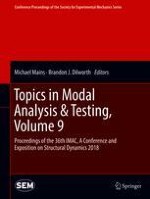2019 | OriginalPaper | Chapter
14. On the Veering Phenomenon Potential in High Speed Gears Design
Authors : Carlo Rosso, Elvio Bonisoli, Fabio Bruzzone
Published in: Topics in Modal Analysis & Testing, Volume 9
Publisher: Springer International Publishing
Activate our intelligent search to find suitable subject content or patents.
Select sections of text to find matching patents with Artificial Intelligence. powered by
Select sections of text to find additional relevant content using AI-assisted search. powered by
